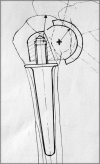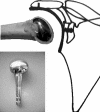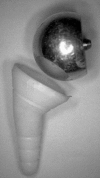Grammont's idea: The story of Paul Grammont's functional surgery concept and the development of the reverse principle
- PMID: 21210311
- PMCID: PMC3148374
- DOI: 10.1007/s11999-010-1757-y
Grammont's idea: The story of Paul Grammont's functional surgery concept and the development of the reverse principle
Abstract
Background: The increased use of the reverse prosthesis over the last 10 years is due to a large series of publications using the reverse prosthesis developed by Paul Grammont. However, there is no article reporting the story of the concepts developed by Grammont.
Questions/purposes: The purposes of this review are to describe the principles developed by Grammont, the chronology of development, and the biomechanical concepts and studies that led to the current design of the reverse prosthesis.
Methods: We selectively reviewed literature and provide personal observations.
Results: From phylogenetic observations, Grammont developed the principle of functional surgery applied to the rotator cuff tears. To increase the deltoid lever arm, he imagined two possibilities: the lateralization of the acromion, which facilitates the action of the rotator cuff, and the medialization of the center of rotation, which has been developed to respond to situations of rotator cuff deficiency. Grammont proposed the use of an acromiohumeral prosthesis, which was quickly abandoned due to problems of acromial loosening. Finally, Grammont used the principle of reverse prosthesis developed in the 1970s, but made a major change by medializing the center of rotation in a nonanatomic location. In 1985, Grammont validated the concept by an experimental study and the first model using a cemented sphere was implanted.
Conclusions: The development of the modern reverse prosthesis is the result of the intellectual and experimental work conducted by Grammont and his team for 20 years. Knowledge of this history is essential to envision future developments.
Figures





References
-
- Arntz CT, Jackins S, Matsen FA., 3rd Prosthetic replacement of the shoulder for the treatment of defects in the rotator cuff and the surface of the glenohumeral joint. J Bone Joint Surg Am. 1993;75:485–491. - PubMed
-
- Barrett WP, Franklin JL, Jackins SE, Wyss CR, Matsen FA., 3rd Total shoulder arthroplasty. J Bone Joint Surg Am. 1987;69:865–872. - PubMed
-
- Basamania C. Hemiarthroplasty for cuff tear arthropathy. In: Zuckermann JD, ed. Advanced Reconstruction—Shoulder. Rosemont, IL: American Academy of Orthopaedic Surgeons; 2007:567–578.
-
- Baulot E, Cavaillé A, Grammont PM. Translation-rotation osteotomy of the spine of the scapula for treatment of impingement syndrome and incomplete cuff tears. Eur J Orthop Surg Trauma. 1993;3:221–226.
Publication types
MeSH terms
Personal name as subject
- Actions
LinkOut - more resources
Full Text Sources

